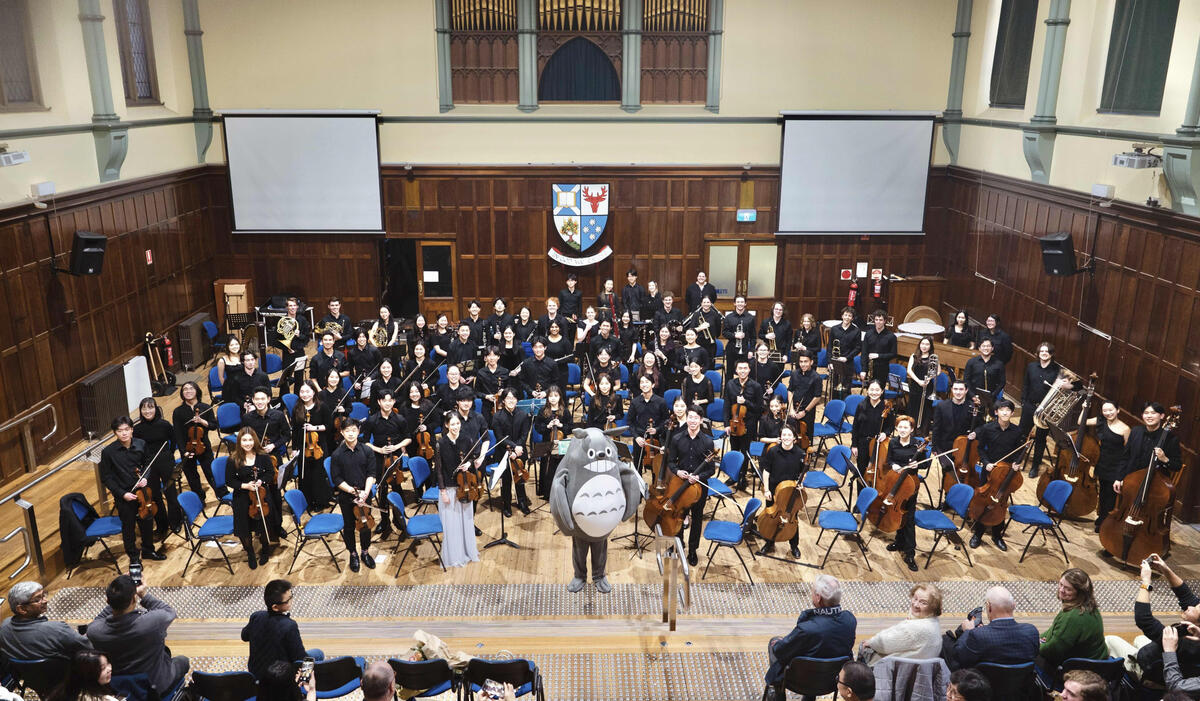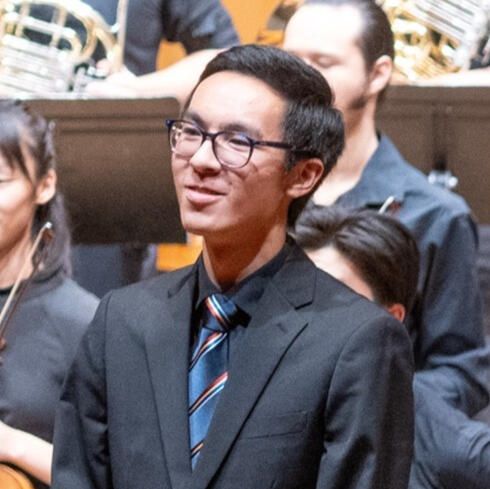MUbso music presents
STORYTELLER
- Program -
Brahms | Piano Concerto No. 1 in D minor, Op. 15
I – Maestoso
II – Adagio
III – Rondo: Allegro non troppo- Interval -Rimsky-Korsakov | Scheherazade, Op. 35I – The Sea and Sinbad’s Ship
II – The Story of the Kalendar Prince
III – The Young Prince and the Young Princess
IV – Festival at Baghdad – The Sea – Shipwreck on a Rock Surmounted by a Bronze Warrior – Conclusion
ABOUT MUBSO

The Melbourne University Biomedicine Students' Orchestra, also known as MUBSO, is a symphony orchestra that brings together students from all faculties of the university who share a passion for classical music, orchestra and charity. Founded in 2016, MUBSO is an UMSU affiliated club at the University of Melbourne that offers a rewarding outlet for students to foster their creative talents and serve the community.Storyteller is our 12th biannual concert, featuring an enchanting program of two epic works. From the cataclysmic intensity of Brahms' Piano Concerto No. 1 to the fantastical melodies of Rimsky-Korsakov's Scheherazade, join us as we set sail on a breathtaking musical journey of delight and wonder.Besides major biannual concerts, MUBSO also has a strong community focus. We have held charity performances over the years at locations such as the Royal Melbourne Hospital, Federation Square, and retirement communities. We also hold an annual Camp where we rehearse and bond over a weekend, culminating in a performance in the community on the last day, usually at a retirement home; this has been a rewarding experience for our members. Since the establishment of the Chamber Music program in 2022, our members have been able to form their own groups to play music in, with a chance to showcase their efforts in an annual Soirée performance in August. Through our musical and social activities throughout the semesters, MUBSO has been able to connect many students with a mutual love of music.
Today, MUBSO has grown into more than just an orchestra, but also a close-knit family that thrives on the diversity of its members with hearts for music and charity. Together, we hope to make a meaningful and positive difference in our community, as we endeavour to bring our music to audiences of all ages and backgrounds. For this concert, we are proud to be supporting Cancer Council Australia, and concert proceeds will be donated towards their mission.We would like to acknowledge the support of Unimelb Faculty of Medicine, Dentistry and Health Sciences, Clubs & Societies, our partners, and of course our MUBSO alumni, friends, and family. Thank you for joining us in our journey and contributing to this incredible community!
ABOUT CANCER COUNCIL

Cancer Council is an independent, not-for profit organisation that has developed an international reputation for innovative work in cancer research, prevention and support. Every year, more than 35,500 Victorians will be diagnosed with cancer, and 11,000 will die from cancer. The number of cases will increase as our population grows and ages. Survival will also improve as we get better at early detection and treatment of cancer.Their goals include: reducing cancer risk & inequities by influencing systems, practices, and policies; saving lives and equitably improving cancer outcomes through screening, early detection, and immunisation; reducing the burden of cancer by supporting, educating, and empowering people and influencing policy change; and discovering & improving prevention, detection, treatment, and care opportunities through ground-breaking cancer research.MUBSO is proud to support Cancer Council Victoria in their mission and we would like to thank the audience for your help in doing so.
MUBSO COMMITTEE
PRESIDENT
Chen LiVICE PRESIDENT
Yuki GohSECRETARY
Freddy PetersenTREASURER
Jasmine YePUBLICITY OFFICER
Daniel LeeEVENTS AND SPONSORSHIPS OFFICER
Melinda SunLIBRARIAN
Annabel LamCATERING MANAGER
Hengly Meas
SOLOIST AND CONDUCTOR

Joshua Zhang
After starting piano lessons at age 7, Joshua swiftly acquired an interest in music as a child. Years later, he continues to be drawn by the unique power of music to portray emotive dialogues. Joshua is actively involved in orchestral and chamber music, performing with University of Melbourne Symphony Orchestra and Melbourne Youth Orchestra, as well as being an avid composer, premiering his Suite for solo piano earlier this year.Aside from musical endeavours, Joshua is currently a final-year postgraduate student at Melbourne Medical School.

Yuki Goh
Yuki graduated with a Bachelor of Music from the Melbourne Conservatorium of Music in 2023, majoring in Composition, as well as a Diploma in Languages, and is currently taking Honours studies at the same institution. He has been the conductor of the Melbourne University Biomedicine Students’ Orchestra (MUBSO) since 2021, the Assistant Conductor of the Heidelberg Symphony Orchestra (HSO) since 2022, as well as the conductor of the Old Scotch Symphony Orchestra (OSSO) since 2024.
Yuki’s musical journey began in classical instrumental performance, having attained proficiency in piano, viola, and harp. He commenced his studies in orchestral conducting in 2019 under the tutelage of Dr John Ferguson. That same year, he made his debut at a combined schools orchestra charity concert, a concert organised by students which raised over $4000 for the Skyline Foundation. He has been involved in conducting engagements with other student orchestras ever since. His other mentors include Nicholas Bochner, Christopher Kopke, and Rick Prakhoff.
As a composition student at the Melbourne Conservatorium of Music, Yuki has studied under the tutelage of Stuart Greenbaum, Melody Eötvös, Miriama Young, Timothy Dargaville, and Christine McCombe. Notable premieres of his works include that of his orchestral piece After Rain Comes the Rainbow, performed by MUBSO in 2022, and his percussion piece Time Stop, performed by the Melbourne Conservatorium of Music Percussion Ensemble under the direction of Brent Miller. He has also had the privilege of workshopping and recording his mixed sextet Where the Quiet Things Are with the Syzygy Ensemble.
MUSICIANS
# Indicates principal
VIOLIN I
Vincent Wong#
Mel Sun
Daniel Bian
Crystal Qian
Hillary Cheng
Jack Risbey
Sher Yen Tan
Nicky Lauw
Stephanie Cho
Isabella Rykers
Thomas Kwan
Chloe Xu
Indigo Munro
Megan Wang
Archie Tong
Xiwen Shang
VIOLIN II
Daniel Lee#
Nicole Chang
Freddy Petersen
Bethany Ah Sang
Emily Mok
Evan Chiu
Eloise Siow-Lee
Ellie Lin
Ting-Wei Hsu
David Ngo
Jacob Ng
Anshan Arnott-Tan
Nick Wang
Tianli Zhang
Anson Zhang
Samantha Chin
Louis Mo
Audrey Choi
VIOLA
Keith Wong#
Joshua Mac
Victoria Sun
Owen Wu
Leila Subocz
Alice Sprung
Ray Zhang
Mila Webb
CELLO
Selena Wiesel#
Madi Muscat
Hamish Vowels
Zio ZhuDOUBLE BASS
Zimo Zhu#
Elsie Yip
Theodore Pham
FLUTE
Chen Li#
Shuhan Zeng
Stephanie Zhou
Hanbi Zhao
Caitlin Noonan (piccolo)
OBOE
Chris Evans#
Winona Lai
CLARINET
Amy Sun#
Katherine Wen
Tom An
Kaden Wynn
BASSOON
Each Zhang#
Seren Adachi
FRENCH HORN
Charlotte Lindsay#
Hannah Boyd-Clark
Sarah Savage
Vivian Liu
TRUMPET
Emma O’Brien#
Felix Geake-Ransome
Frances Reid
TROMBONE
Maeve Tan#
Tingxuan Wang
Hengly MeasTUBA
Finnlay Hansen
PIANO
Elias BatshonHARP
Jasmine Ye
PERCUSSION
Jacqui Wang
Eunice Huang
Tracey Quan-Nguyen
Brandon Pai
Russell LiaoTIMPANI
Amelia Liu
Chris Cheng
Program notes

Johannes Brahms (1833 – 1897)Piano Concerto No. 1 in D minor, Op. 15
I – Maestoso
II – Adagio
III – Rondo: Allegro non troppoBrahms’ First Piano Concerto is one of the monumental piano concertos written since Beethoven’s ‘Emperor’ Concerto, the former surpassing the latter both in length and emotional intensity. The work was initially conceived of as a two-piano sonata in 1854, but then the composer soon realised that such musical material required orchestral treatment, so he then reworked his ideas into a piano concerto and continued to revise it until its premiere performance five years later in January 1859. Whilst this concerto is a tour de force for any pianist, the work is not an explicit display of technical virtuosity in the sense one may attribute to the piano music of Rachmininoff or Liszt. Rather, Brahms’ concerto pits the emotional and the musical in the forefront, and demands both sensitivity and imagination from both soloist and orchestra.The first movement opens with a clear sense of tragedy and catastrophe, a musical response to Robert Schumann’s (Brahms’ close friend, mentor, and advocate for his music) suicide attempt in 1854. A thunderous tonic pedal, menacing trills, and threatening timpani rolls characterise the statement of this first of three main themes in the orchestral exposition. After the theme reaches a climax, the music dissolves into a more lyrical but melancholic theme in the home key of D minor, evoking a gently flowing river with its undulating ostinato accompaniment that is based on the first theme. A mysterious and shimmering third theme in B-flat minor furthers the atmosphere of defeat and resignation. After a violent renewal of the first theme, the orchestra makes way for the soloist’s first entry – a gently rocking but hushed melody – before it courageously rises in a crescendo towards the menacing trills of the first theme. Each of the exposition’s themes are stated by the soloist, but the music then warms with brightness and hopefulness as a tender and hymn-like fourth theme is introduced, first played by the soloist, then repeated warmly and expressively by the strings. A stormy development restates and embellishes the main themes in the order they were first introduced, before climactic alternating chords between orchestra and soloist lead to the recapitulation of the first theme – this time in the unusual key of E major above a pedal D. Whilst the hymn-like fourth theme is recapitulated in the parallel major of D major, seemingly bringing this portion of music to a consoling and serene close, the tumultuous coda roars back into the tragic home key of D minor, and the movement concludes with unrelenting drama and turbulence.If the first movement dealt with the topic of earthly struggles, the heavenly, ternary form second movement, written in the parallel major, transports the listener to an otherworldly realm of peace and tranquillity. The opening melody in the strings is church-like, demonstrating Brahms’ indebtedness to Renaissance choral music such as that by Palestrina. Beneath the opening bars of this melody, Brahms had written the words “Benedictus, qui venit in nomine Domini” (Blessed is he who comes in the name of the lord). Not only does this movement reflect a devotional spirit to the masters of old, but also a love for Robert Schumann’s wife, Clara, with whom Brahms developed a deep friendship and to whom he wrote “I am painting a gentle portrait of you” upon writing this movement. The soloist’s first entry seems to emerge from the ethereal beauty of the first theme, transforming the mood into a personal reflection. The choir-like entries of the orchestra alternate with the more intimate and introspective entries of the soloist before both unite in dialogue in the movement’s middle section – a melancholic melody that is more ingrained in Romantic expression. The chorale-like first theme then returns before developing to a climax – a radiant and expansive theme played by the winds above cascading arpeggios in the solo part. This renewed sense of hope dissipates, and the hushed intimacy returns, from which a piano cadenza emerges, characterised by trills and arpeggios moving upward in trajectory, perhaps depicting an ascent towards the heavens, before the orchestra solemnly recalls the first theme, this time with the 7th scale degree flattened to create a modal quality.Brahms looked towards Beethoven for inspiration for the third movement – an energetic rondo modelled on the structure of the third movement of Beethoven’s Third Piano Concerto. The main theme is first stated alone by the soloist before the orchestra answers. A series of episodes alternate with the main theme, and these new themes vary in character – from lyrical, to dubious, to defiant. A middle fugato section based on fragments of all the themes introduced thus far in the movement features the orchestra in the foreground in a playful, sprightly character, before the soloist re-enters with a lighthearted but fleeting restatement of the main theme in the relative major. After a Beethovenian climax, a more substantial piano cadenza follows before the arrival of a D major coda. The concerto concludes on a hopeful and triumphant note.

Nikolai Rimsky-Korsakov (1844 – 1908)Scheherazade, Op. 35
I – The Sea and Sinbad’s Ship
II – The Story of the Kalendar Prince
III – The Young Prince and the Young Princess
IV – Festival at Baghdad – The Sea – Shipwreck on a Rock Surmounted by a Bronze- Warrior – ConclusionThe symphonic suite Scheherazade was written in 1888 at the height of Rimsky-Korsakov’s creative powers and remains an audience favourite today for its lush orchestration, memorable themes, and vivid imagery. The work was inspired by the Middle Eastern folktales One Thousand and One Nights, where each movement of the suite depicts a different episode from the collection. According to legend, the cruel Sultan Shahriar was convinced that women were faithless, and sworn to take in a new bride every night only to have her put to death the following morning. That is until one, the beautiful and captivating Scheherazade, endeavoured to tell the Sultan interesting stories each night and being sure to end each night in the middle of a tale, so that driven by curiosity, the Sultan spared her life for one thousand and one nights before abandoning his bloodthirsty resolution altogether.The first movement begins with a menacing depiction of the evil Sultan played in unison by the orchestra, a theme which would recur numerous times throughout the suite in different guises. This is answered by the seductively charming Scheherazade, who is represented throughout the work by solo violin accompanied by enchanting broken chords in the harp. The bulk of the opening movement describes Sinbad’s voyage by ship as well as the waves of the sea which are represented by a gently rocking ostinato in the cellos, above which the violins introduce a melody in E major that is based on the Sultan’s theme. As a synesthete, Rimsky-Korsakov associated different keys with different colours, and for him, he associated blue, the colour of the ocean, with the key of E major. Whilst the themes are frequently repeated in this movement, Rimsky-Korsakov creates interest and drama by depicting varying degrees of turbulence and violence of the sea – from calm, to moderate, to tumultuous.The second movement opens with Scheherazade’s theme in the solo violin and harp, before we are transported to the land of the oriental as the theme of the Kalendar Prince is introduced by a seductive bassoon solo above bass drone chords. This lyrical theme is passed from section to section, each time in a different character, from the expressiveness of the oboe, to the playfulness of the strings, to the vibrance of the winds. A dramatic middle section featuring solo instrument cadenzas takes place before the music moves into an energetically playful dance-like section. The movement’s main theme returns after that, before restated one final time by solo flute above sparkling harp chords and shimmering strings in a nocturnal dreamscape. The music picks up its pace in the final bars and grows in expectation and excitement towards the final flourish.The third movement is a sensual love affair between a young prince and a young princess, each character represented by a different theme in the movement. The noble, warmhearted prince is first introduced by the strings with a dreamy and delicate melody, and is restated by various instruments before a new theme enters the picture – a zestful and spirited theme representing the youthful princess – played first by solo clarinet. The music then transitions back to Scheherazade’s theme, temporarily casting our minds out of the romance story as a musical interlude. The prince’s theme then emerges from the solo violin cadenza before the movement reaches its emotional climax – a sign of the passionate love between the two characters. The princess’ theme is restated once more, this time livelier and reaching a new emotional height, before the movement concludes in a whimsical and lighthearted manner.The final movement opens with drama – an enraged Sultan throwing a tantrum, against whom a desperate Scheherazade attempts to stand her ground and confront. After this introduction, a bustling festival gets underway, represented by a lively, dance-like new theme. Throughout the movement, Rimsky-Korsakov recalls the themes heard previously in the earlier movements. As the festival’s energy and activity grows in excitement, it grows to a climax and the piece reaches its loudest and most violent point – a reinvigorated return of the theme of Sinbad’s ship and the sea played fortissimo by the trombones accompanied by thunderous percussion, depicting a catastrophic shipwreck. The chaos and the clamour subsides before Scheherazade’s theme is restated one final time, in its most vulnerable and intimate manner, and the suite concludes with a subdued and somewhat gentler Sultan, bringing the magical tales of Scheherazade, as well as the music, to a tranquil close.


